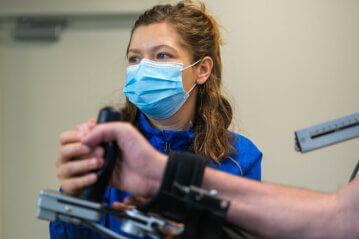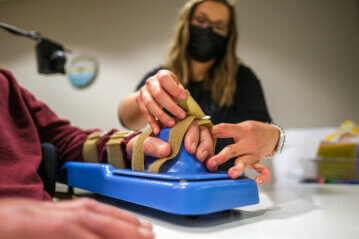For many of us, technology is a convenience. Amazon delivers whatever we need to our doorstep. Alexa tells us the weather while we are getting ready in the morning. Siri answers our every inquiry with a wealth of internet resources. Online apps deliver us food or groceries. All of this exists to make us more efficient—to make our lives easier.
But for many others, these tool serve as assistive technology—a means to assist them in living more independently. For you, Ring offers you the ability to answer your door. For others, it allows a higher level of security and screening when they don’t have the ability to physically answer the door. App-controlled blinds, thermostats, and televisions allow for a change with the push of a button.
Convenience for you, the only option for someone with a spinal cord injury. Instead of having to ask for help with every task, it allows individuals the freedom and control over their own environment.
QLI Occupational Therapists Morgan Chapman, Corey Cundall, and Sara Waid offer their opinions and expertise in understanding the impact of this everyday yet extraordinary technology. All three are tasked with assisting clients to develop a great-working method to ease the routines and activities in their lives.
Value and Benefit of Assistive Tech
Q: What is the therapeutic value of these assistive technology devices?
Cundall: One of the things I do first when starting out with clients is I ask myself—what are we working towards? To answer this I create a hypothetical list with the client, going over what they are or are not able to do, and determining if “x, y, or z” technology could be used to assist them in accomplishing those goals. Clinicians are taught early on in our education that therapies are aimed at meeting either compensation (learning to do something in a new way) or remediation (learning to do something the way you used to do it). I sometimes advocate for assistive technology with clients as a means of compensation for tasks while we work on remediation.
Even so, there are many tasks that must be compensated for our clients. While we introduce technology such as voice-activated televisions or light switches, there’s also the capability to assist with tasks like eating food. At QLI, we have a device called Obi, which can, with a spoon, lift food from a plate so the client can eat it. Further, we can introduce technology that tracks your eye movement on a screen, allowing you to type. There’s just so much that exists which we can use to help our clients.
Waid: Some of the rooms on QLI’s campus have been outfitted with more advanced technology for clients to trial use before they make the investment. Some are common devices that are a simple, low-cost solution to a complex need. One device I frequently recommend to clients is the Google Nest, which has drop-in capabilities. This means that cameras are set up so loved ones or caregivers can visually check in. We also frequently use devices such as the Echo or Google Home which can offer a variety of shortcuts including turning lights on and off, locking and unlocking doors, to name a few.
Q: How do you determine who might benefit from the use of assistive technology?
Waid: It depends on the individual. As they come into QLI we perform an evaluation to assess the potential barriers. Then we are able to match current technology to address that gap. We look at so much more than home access technologies, as we also review the accessibility on our phones— determining and aiding clients in being able to access features such as their calendar, text messages, and social media accounts. QLI’s Information Technology (IT) department is an essential part of the team, collaborating or troubleshooting various scenarios for our clients. For example, I recently worked with a client who was deaf, and therefore could not hear someone knocking on the door to his room. We worked with IT to find a very inexpensive lighted-doorbell that could be placed outside his room.
Q: When clients discharge and you follow up with them, how do their continued development with assistive technologies inform your sessions with other clients who are using these technologies?
Chapman: When a client is close to discharging, we’ll spend time with going over devices they might 
Incorporating Into Programs and Future
Q: Do you ever face any pushback when attempting to incorporate assistive devices into client’s programs, and in turn their lives?
Waid: We do. The degree of comfortability that our clients have ties into what they were used to prior to their injury. For some, that meant utilizing a smartphone was the extent of that familiarity and the idea of introducing more technology may be overwhelming. However, others may have had a wealth of experience and interest in devices such as an Echo or Dot. For those whose confidence peaks with using a smartphone, we’ll typically hold off on suggesting devices again until they are further along in their program. As we start to approach discharge and assess a client’s home environment, their level of comfort may increase because they are close to going home, are more confident in their situation and are more accepting to those devices will really help them succeed.
Trial and error also plays a role in this process. Sometimes it takes struggling in a certain task to
Chapman: In my experience, most clients with spinal cord injury are willing to incorporate assistive technology into their program from the start. Typically any hesitancy that may arise occurs when the technology is a little more difficult to learn. We see that a lot with a great piece of technology like Dragon, which helps individuals use speech-to-text functions on a computer. While a great development, it can be difficult to learn how to use initially. In these moments, we focus on providing encouragement for clients, and work them through learning repetitions to grasp the material and commands. It’s all about finding a way to lessen or work around any frustration that may arise.
Q: What is an area of assistive tech in which you hope to see further development?
Chapman: I think a priority would be improving assistive tech that heavily relies on a WiFi connection. If the power or internet goes down, it can be very difficult for a client to restart these devices.
Cundall: One big step that could be taken is improving “hands-free” technology. While voice technology such as Siri is helpful, there have been many times where something is lost in translation, and the client will need to delete what Siri has processed.
Categories: Activities of Daily Living, Assistive Technology, Brain Injury, Occupational Therapy, Spinal Cord Injury

